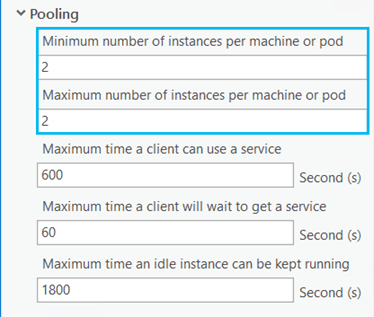You can configure properties for locators that you share to your portal using the Share Locator pane. You do this during the sharing configuration process on the Configuring tab of the Sharing pane before you share.
These properties are described below.
Capabilities
Expand the Capabilities section and choose the capabilities to enable for your portal locator. Capabilities specify the allowed operations for your geocode service. The options are as follows:
- Geocode—Find addresses or geocode a table of addresses.
- Reverse Geocode—Return an address for a point location on a map.
- Suggest—Generate autocomplete suggestions for user input.
Parameters
Expand the Parameters section and set the basic parameters for your locator shared to your portal. The parameters are as follow:
Choose the cluster hosting the service—The cluster that will host your locator. A cluster is a group of one or more GIS servers that work together to provide services to clients.
-
Maximum number of candidates returned by the server—The number of candidates returned when you find addresses interactively. The response time is faster when there are fewer candidates to return. This parameter applies to both SOAP and REST applications.
-
Maximum number of records to be processed in each batch job—The number of record sets to be processed at a time on the server when you geocode a table of addresses. The default value of 1000 is an optimal size for avoiding large overhead costs and excessive consumption of CPU resources in the server. This parameter only applies to applications using SOAP.
-
Recommended number of records to pass in each batch job—The number of records the client passes to the server for processing at a time on the server when you geocode a table of addresses. This value must not exceed the value of the Maximum number of records to be processed in each batch job parameter. In most cases, both parameters are set with the same value. Using this parameter, the server administrator can optimize the process by controlling the number of records to be passed to the server in each batch geocoding request.
Pooling
Expand the Pooling section and specify the minimum and maximum number of instances of the portal locator that can run per server machine (or per pod if you are connected to ArcGIS Enterprise on Kubernetes) at any one time. Because of the way the server shares these instances among clients, it is possible that the number of clients the server can support is greater than the number of running instances. You must increase the number of instances if the service experiences high traffic or if you plan to parallelize your batch geocoding jobs.

Note:
To ensure that maximum resources are always available for geocoding, set Minimum number of instances per machine or pod and Maximum number of instances per machine or pod to the same value.The Pooling properties allow you to specify how the portal locator will accommodate users.
Processes
Expand the Processes section and specify how the portal locator will run as a process on the server.